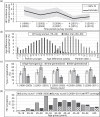Age-disparate relationships and HIV incidence in adolescent girls and young women: evidence from Zimbabwe
- PMID: 28426534
- PMCID: PMC5457819
- DOI: 10.1097/QAD.0000000000001506
Age-disparate relationships and HIV incidence in adolescent girls and young women: evidence from Zimbabwe
Abstract
Objective: Age-disparate sexual relationships with older men may drive high rates of HIV acquisition in young women in sub-Saharan Africa, but evidence is limited. We investigate the association between age-disparate relationships and HIV incidence in Manicaland, Zimbabwe.
Design: A general-population open-cohort study (six surveys) (1998-2013).
Methods: A total of 3746 young women aged 15-24 years participated in consecutive surveys and were HIV-negative at the beginning of intersurvey periods. Last sexual partner age difference and age-disparate relationships [intergenerational (≥10 years age difference) and intragenerational (5-9 years) versus age-homogeneous (0-4 years)] were tested for associations with HIV incidence in Cox regressions. A proximate determinants framework was used to explore factors possibly explaining variations in the contribution of age-disparate relationships to HIV incidence between populations and over time.
Results: About 126 HIV infections occurred over 8777 person-years (1.43 per 100 person-years; 95% confidence interval = 1.17-1.68). Sixty-five percent of women reported partner age differences of at least 5 years. Increasing partner age differences were associated with higher HIV incidence [adjusted hazard ratio (aHR) = 1.05 (1.01-1.09)]. Intergenerational relationships tended to increase HIV incidence [aHR = 1.78 (0.96-3.29)] but not intragenerational relationships [aHR = 0.91 (0.47-1.76)]. Secondary education was associated with reductions in intergenerational relationships [adjusted odds ratio (aOR) = 0.49 (0.36-0.68)]. Intergenerational relationships were associated with partners having concurrent relationships [aOR = 2.59 (1.81-3.70)], which tended to increase HIV incidence [aHR = 1.74 (0.96-3.17)]. Associations between age disparity and HIV incidence did not change over time.
Conclusion: Sexual relationships with older men expose young women to increased risk of HIV acquisition in Manicaland, which did not change over time, even with introduction of antiretroviral therapy.
Figures


Similar articles
-
Do age-disparate relationships drive HIV incidence in young women? Evidence from a population cohort in rural KwaZulu-Natal, South Africa.J Acquir Immune Defic Syndr. 2014 Aug 1;66(4):443-51. doi: 10.1097/QAI.0000000000000198. J Acquir Immune Defic Syndr. 2014. PMID: 24815854 Free PMC article.
-
Sexual mixing patterns and sex-differentials in teenage exposure to HIV infection in rural Zimbabwe.Lancet. 2002 Jun 1;359(9321):1896-903. doi: 10.1016/S0140-6736(02)08780-9. Lancet. 2002. PMID: 12057552
-
HIV Risk Among Adolescent Girls and Young Women in Age-Disparate Partnerships: Evidence From KwaZulu-Natal, South Africa.J Acquir Immune Defic Syndr. 2018 Jun 1;78(2):155-162. doi: 10.1097/QAI.0000000000001656. J Acquir Immune Defic Syndr. 2018. PMID: 29767637 Free PMC article.
-
Age-disparate and intergenerational sex in southern Africa: the dynamics of hypervulnerability.AIDS. 2008 Dec;22 Suppl 4:S17-25. doi: 10.1097/01.aids.0000341774.86500.53. AIDS. 2008. PMID: 19033752 Review.
-
Risk of HIV infection among adolescent girls and young women in age-disparate relationships in sub-Saharan Africa.AIDS. 2020 Aug 1;34(10):1539-1548. doi: 10.1097/QAD.0000000000002582. AIDS. 2020. PMID: 32443063
Cited by
-
Partner age difference and sociodemographic correlates of herpes simplex virus type 2 seropositivity: A community-based study in South India.Indian J Sex Transm Dis AIDS. 2020 Jul-Dec;41(2):219-221. doi: 10.4103/ijstd.IJSTD_90_18. Epub 2020 Jul 31. Indian J Sex Transm Dis AIDS. 2020. PMID: 33817604 Free PMC article. No abstract available.
-
Determining HIV risk for Adolescent Girls and Young Women (AGYW) in relationships with "Blessers" and age-disparate partners: a cross-sectional survey in four districts in South Africa.BMC Public Health. 2022 May 14;22(1):973. doi: 10.1186/s12889-022-13394-4. BMC Public Health. 2022. PMID: 35568839 Free PMC article.
-
Effect of Schooling on Age-Disparate Relationships and Number of Sexual Partners Among Young Women in Rural South Africa Enrolled in HPTN 068.J Acquir Immune Defic Syndr. 2017 Dec 15;76(5):e107-e114. doi: 10.1097/QAI.0000000000001544. J Acquir Immune Defic Syndr. 2017. PMID: 28902703 Free PMC article.
-
"Any time because I am ready": Willingness to use long-acting injectable HIV PrEP among female barmaids in Dar es Salaam, Tanzania.Front Public Health. 2025 Mar 19;13:1511801. doi: 10.3389/fpubh.2025.1511801. eCollection 2025. Front Public Health. 2025. PMID: 40177091 Free PMC article.
-
Contextual drivers of HIV risk among young African women.J Int AIDS Soc. 2019 Jul;22 Suppl 4(Suppl Suppl 4):e25302. doi: 10.1002/jia2.25302. J Int AIDS Soc. 2019. PMID: 31328409 Free PMC article.
References
-
- Shisana O, Rehle T, Simbayi LC, Zuma K, Jooste S, Zungu N, et al. South African national HIV prevalence, incidence and behaviour survey, 2012. Cape Town, South Africa: Human Sciences Research Council, South Africa; 2014.
-
- UNAIDS. Zimbabwe HIV epidemic profile. Harare, Zimbabwe: UNAIDS Country Office Zimbabwe; 2014.
-
- Hallett TB, Gregson S, Lewis JJC, Lopman BA, Garnett GP. Behaviour change in generalised HIV epidemics: impact of reducing cross-generational sex and delaying age at sexual debut. Sex Transm Infect 2007; 83 Suppl 1:i50–i54. - PubMed
-
- Hope R. Addressing cross-generational sex: a desk review of research and programs. Washington, DC: Population Reference Bureau; 2007.
Publication types
MeSH terms
Grants and funding
LinkOut - more resources
Full Text Sources
Other Literature Sources
Medical

